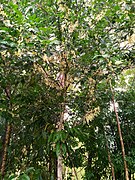|
Lepiderema sericolignis
Lepiderema sericolignis, commonly known as silkwood, is a plant in the maple and lychee family Sapindaceae found only in the Wet Tropics bioregion of Queensland, Australia. DescriptionLepiderema sericolignis is a small tree to about 4 m (13 ft) high. The compound leaves have 2, 3, or rarely 4 pairs of leaflets that are glossy green above and dull green below. The leaflets are held on very short pulvinate stems about 5 mm (0.20 in) long. They measure up to 16 cm (6.3 in) long and 6 cm (2.4 in) wide and are elliptic in outline, with between 7 and 12 pairs of lateral veins in the blades.[4][5][6] The inflorescences are short spikes about 4.5 cm (1.8 in) long, produced in small clusters on old wood and in the leaf axils. Flowers are either male or female, white to creamy yellow, with 5 petals and measuring about 5 mm (0.20 in) wide. The fruit is a globose, apricot/orange capsule up to 2 cm (0.79 in) long and wide, with three segments each containing a single black seed almost fully enclosed in a yellow aril. The capsules persist on the branches after ripening and dry dark brown or black.[4][5][6] PhenologyFlowering occurs between March and May, and fruit are ripe from August to December.[7][8][a] TaxonomyThis species was first described in 1892 as Cupania sericolignis by the Australian botanist Frederick Manson Bailey.[9] In 1924, the Bavarian botanist Ludwig Adolph Timotheus Radlkofer transferred it to the current genus Lepiderema.[2] EtymologyThe genus name Lepidorema is from the Ancient Greek words lepís meaning a scale or flake, and erêmos meaning "bereft of" or without. It refers to the scale-less petals.[4] The species epithet sericolignis is derived from the Ancient Greek sērikós meaning silky, and the Latin lignis meaning wood, and is a reference to the sheen of the timber.[7] Distribution and habitatLepiderema sericolignis inhabits rainforest, often close to rivers or mangrove communities, from around Rossville southwards to about Ingham. The altitudinal range is from sea level to about 1,000 m (3,300 ft).[4][6][7][10] ConservationThis species is listed as least concern under the Queensland Government's Nature Conservation Act.[1] As of 23 April 2024[update], it has not been assessed by the International Union for Conservation of Nature (IUCN). Gallery
References
Notes
External linksWikimedia Commons has media related to Lepiderema sericolignis.
|
||||||||||||||||||||||||||||||||||||||
Portal di Ensiklopedia Dunia





